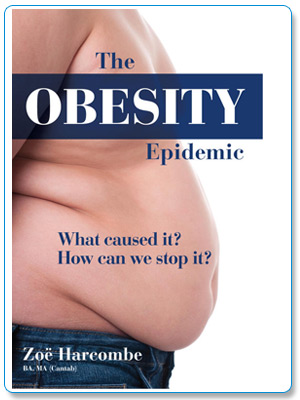Chapter 8
I love the opening to Part 3 – we remind ourselves of why we eat – because we die without the nutrients that food provides. But we also look at the empty calories that we are eating today – almost 1,100 calories of sugar and flour in both the UK and the USA – sugar providing no nutrients and flour providing so little naturally that it is invariably fortified. I do a little experiment, using the United States Department of Agriculture database of the nutritional content of food. I try to see – if only we swapped out these 1,100 largely useless calories for the most nutritious foods – could we get our minimal nutritional requirements met? The interesting lessons are in the exercise itself, as much as the results.
The heart of the story of “The Obesity Epidemic” is the fact that we changed our diet advice –a U-turn more like – and obesity has increased 10 fold since in the UK and many times over in the USA. The most obvious question to ask is “Why did we change our diet advice?” and that is exactly what Chapter 8 does.
We go back to the 1950’s when a man called Ancel Keys set out to try to find a culprit in the search for what was causing heart disease amongst American men (and I mean men). He set out to see if cholesterol eaten in food had any impact on cholesterol levels in the blood and he categorically concluded that it did NOT. He never changed his view on this – although the majority of people today still think they need to avoid eggs (one of the most nutritious foods on the planet) because of the cholesterol that they contain. This just shows how easy it is for wrong information to become folklore.
Having failed to find a connection between cholesterol and heart disease, Keys tried to establish a link between saturated fat and heart disease. This has no logic at the outset, because the same foods that contain cholesterol contain saturated fat. However, Keys hand picked seven countries and did “The Seven Countries Study”. Just as with the experiment in Chapter 4, this is an absolute must read study for anyone working in the field of food, health and weight, but I rarely meet people who have heard of it, let alone studied it.
In Chapter 8, I go back to the original 1970 publication of the 20 volumes of the study and I tear them apart.
If, at the end of this chapter, you still believe that the case has been made against saturated fat, as Dr Kendrick said in his review of the book, you did not understand what you just read.
Chapter 8 is possibly the most important chapter in the book. It will also explain the utterly vital role played by cholesterol in the body and hopefully, by the end of the chapter, you will be as shocked as I am that people are actively trying to lower their cholesterol levels – to lower something quite so life critical.

